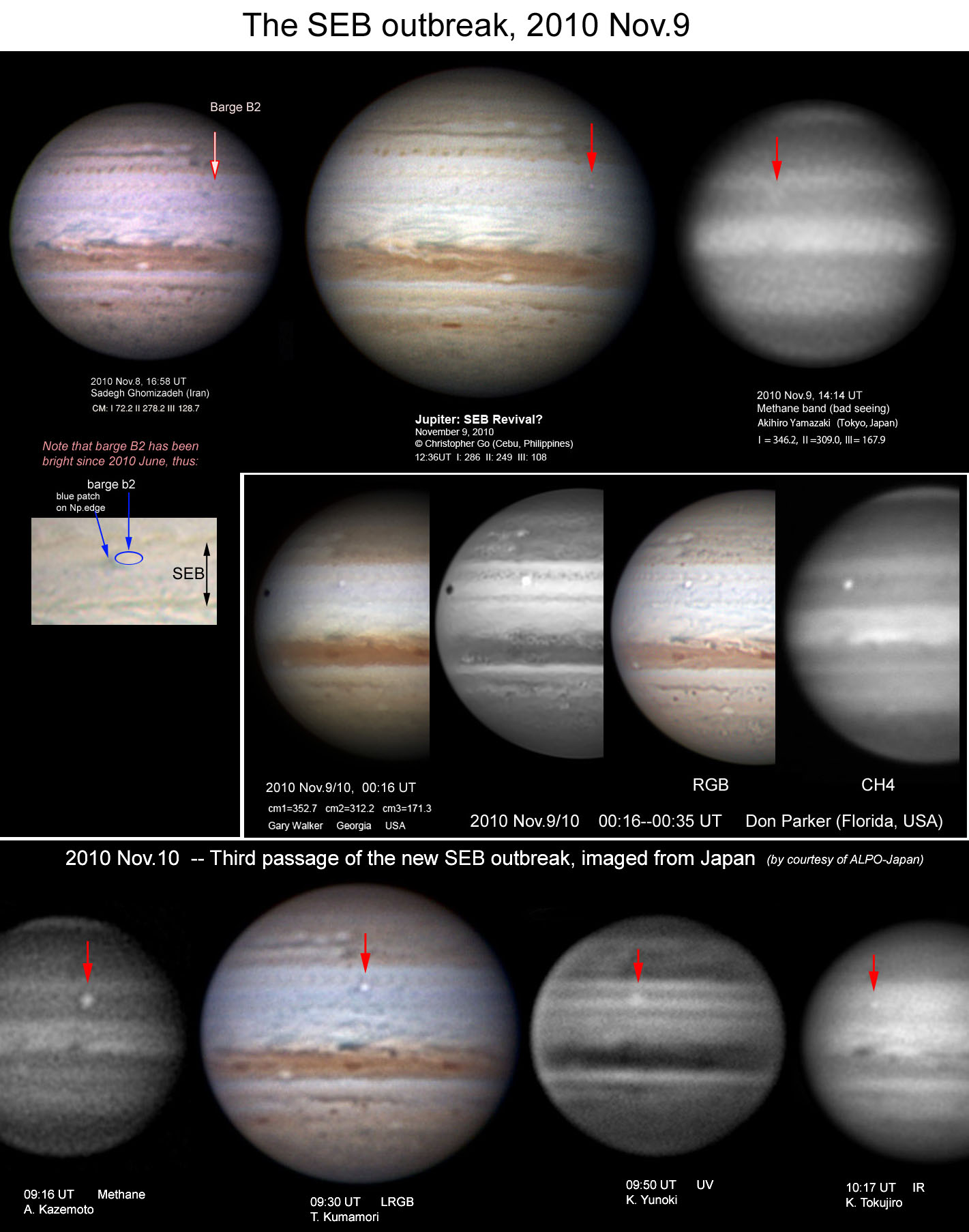|
The SEB Revival is beginning by John H.Rogers
|
GOTO Japanese 日本語はこちら
Hello all,
Here is a round-up of the exciting events on Jupiter over the past 36 hours
(with apologies to those who have heard and seen all this several times
already). The text below has just been sent out as a BAA e-bulletin.
Of course, images are still coming in: Tomio Akutsu has sent a splendid
multispectral set from the third rotation, and Dave Tyler and Martin
Mobberley have just imaged the outbreak on its fourth rotation, when it
was very bright but almost obscured by Europa!
Best wishes,
John
Jupiter: The SEB Revival is beginning
A spectacular bright plume has appeared in Jupiter's faded South Equatorial
Belt (SEB), and is expected to become the source of vigorous disturbances
leading to revival of the belt. The small bright spot was discovered by
Christopher Go (Philippines) in an image which he took on Nov.9 at 12:30 UT.
He announced it immediately by e-mail, and it was strikingly confirmed
11-12 hours later by Donald C. Parker (Florida, USA) and Gary Walker
(Georgia, USA), when it was already brighter.
Don Parker's images included infrared, ultraviolet, and 0.89 micron
(methane) bands, and the new spot was amazingly bright in all of them,
showing it to be a convective plume of cloud reaching to very high altitude.
Indeed it was already visible in a methane-band image taken in poor seeing
by A. Yamazaki (Japan) on Nov.9 at 14:14 UT. On its third rotation, Nov.10
from 09:00 UT onwards, images by many Japanese observers and by C. Go and
T. Akutsu (Philippines) confirm that it is the brightest spot on the planet
in all wavebands. Its longitude is L2 = 290 (L3 = 149). (The Great Red
Spot is at L2 = 159.)
This plume has appeared inside a cyclonic circulation, called 'barge B2',
which had been very dark a year ago, but turned white in 2010 May-June.
(Details are in our reports:)
http://www.britastro.org/jupiter/2010report05.htm
and
http://www.britastro.org/jupiter/2010report08.htm [Figure 11].
Thus the former barge already comprised a white spot, but it was not
methane-bright (up to Nov.7: Chris Go). It was still quiet on Nov.8
(Sadegh Ghomizadeh, Iran). So the much brighter plume was new on Nov.9.
We had already suggested that the SEB Revival might begin with such a plume
in one of the barges, as it did in 2007; the event is a striking confirmation
of this hypothesis.
This rapidly brightening plume is so energetic that we can confidently expect
it to develop into the SEB Revival. The SEB Revival is usually spectacular,
so we can expect impressive and rapidly changing disturbances over the next
3 months, until the end of the apparition. As the SEB is so thoroughly
whitened, and the outbreak has appeared in an isolated location, we can
hope to see the phenomena displayed in their most complete form. Normally,
disturbances continue to arise at the same source, and spread out in three
branches: northern and central branches, prograding, and a southern branch,
rapidly retrograding. If they develop as usual, both the central and
southern branches could impact on the Great Red Spot in January. Observers
should monitor all aspects of the spreading disturbances, but also monitor
other longitudes, as a secondary source might also appear. Observers have
the chance to make this the best-observed SEB Revival ever.
_________________________________
John H. Rogers, Ph.D.
Jupiter Section Director,
British Astronomical Association
 John H. Rogers,Ph.D.
Jupiter Section Director,
[British Astronomical Association.]
John H. Rogers,Ph.D.
Jupiter Section Director,
[British Astronomical Association.]
●木星、SEB復活が始まる
これは過去36時間の木星のエキサイティングな出来事の要約である(すでに何回も
見聞きした人には申し訳ない)。以下の文章はBAAブレティン電子版としてちょうど
送信した。もちろん、画像は今も届いていて、例えばTomio Akutsuからは第3自転
の素晴らしいマルチスペクトル画像が届き、Dave TylerとMartin Mobberleyは、
とても明るいがユーロパによってほとんどが隠されている、第4自転のアウト
ブレークをちょうど撮影している。
John
--------------------
●木星、SEB復活が始まる
見事な輝くプルームが木星の淡化した南赤道縞(SEB)に出現していて、ベルトの
復活を導く強い攪乱の発生源になると期待されている。小さな輝点はChristopher
Go(Philippines)が11月9日12:30UTに撮影した画像で発見した。彼はただちに電子
メールで公表して、Donald C. Parker(Florida, USA)とGary Walker(Georgia,
USA)によって11-12時間後に印象的に確認されたが、その時にはすでにかなり明るく
なっていた。
Don Parkerの画像には、赤外(IR)、紫外(UV)、0.89ミクロン(メタン)バンドが含ま
れるが、新しい白斑はそのどれでも驚くほどに明るく、これは白斑が非常に高い
高度まで達している雲の対流プルームであることを示す。確かに、11月9日14:14UT
にA. Yamazaki(Japan)によって悪シーイング下で撮影されたメタンバンド画像に
すでに見られる。第3自転では、11月10日09:00UT以降に、多くの日本の観測者や
C. GoやT. Akutsu(Philippines)による画像によって、全ての波長で最も明るい
白斑であることが確認されている。その経度はL2=290度(L3=149度)である。
(大赤斑はL2=159度である。)
このプルームは、バージB2と呼ぶ低気圧性循環気流の内部に出現している。バージ
は1年前には非常に暗かったが、2010年5-6月に白く変化した(詳細は我々のレポート
にある)。
http://www.britastro.org/jupiter/2010report05.htm
http://www.britastro.org/jupiter/2010report08.htm [Figure 11]
こうして、以前のバージはすでに白斑から成るが、メタンブライトではなかった
(11月7日まで、Chris Go)。さらに11月8日にも静かであった(Sadegh Ghomizadeh,
Iran)。そして、さらに明るいプルームは11月9日に新しいものであった。SEB復活
は、2007年に起こったように、バージの一つでのこのようなプルームで始まるかも
しれないとすでに提唱してきたが、今回の出来事はこの仮説の印象的な検証である。
この急速に明るくなっているプルームはかなり力強いので、自信を持ってこれが
SEB復活に発達すると期待できる。SEB復活は通常は劇的なので、観測期の終わり
まで、これからの3ヵ月は印象的で急速に変化する攪乱を期待できる。SEBはすっ
かり白くなっていて、またアウトブレークは孤立した場所に出現しているので、
最も完全な形で示される現象を見られると願っている。通常は、攪乱は同じ発生
源で出現し続けて、前進する北分枝と中央分枝、急速に後退する南分枝という、
3つの分枝で拡がる。攪乱が通常のように発達すれば、中央分枝と南分枝の両方が
1月に大赤斑に衝突するだろう。観測者は拡がっていく攪乱の全ての様相を監視す
るばかりでなくて、さらに副次的な発生源が出現するかもしれないので、他の経
度も監視する必要がある。観測者にはこれまでで最高に観測されたSEB復活を作る
チャンスを得ている。
 John H. Rogers, Ph.D.
Jupiter Section Director,
British Astronomical Association
【日本語訳:伊賀祐一】
John H. Rogers, Ph.D.
Jupiter Section Director,
British Astronomical Association
【日本語訳:伊賀祐一】
 ALPO-Japan Latest ALPO-Japan Latest  Jupiter Section Jupiter Section
|
John H. Rogers,Ph.D. Jupiter Section Director, [British Astronomical Association.]
John H. Rogers, Ph.D. Jupiter Section Director, British Astronomical Association 【日本語訳:伊賀祐一】
ALPO-Japan Latest
Jupiter Section